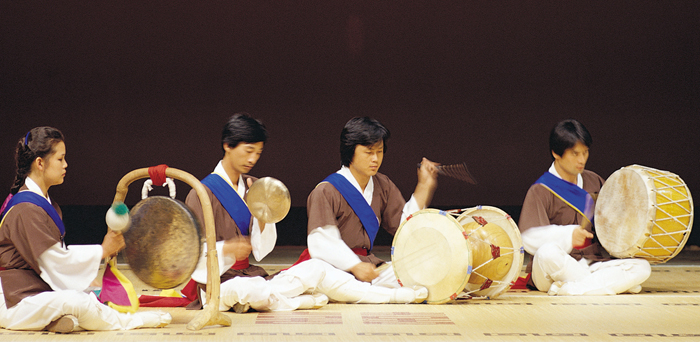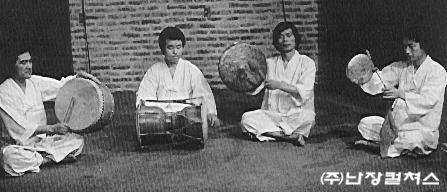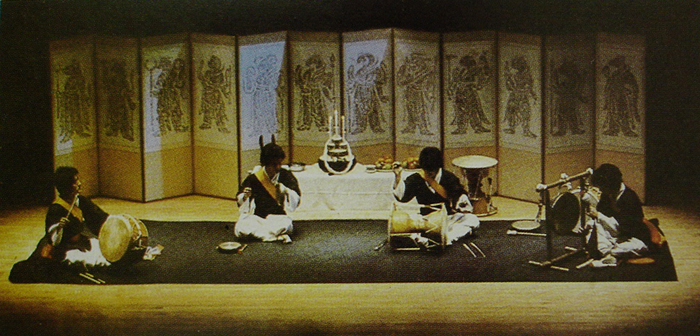indicator
Samulnori (Percussion Instrumental Quartet Music of Korea) – instruments of nature
This innovative and captivating genre of traditional Korean music blends different percussion instruments to create perfect harmony.

<Four Samulnori instruments (from left to right): Jing, kkwaenggwari, janggu,and buk.>
Samulnori ("samul" means "four things" and "nori" means "to play") is a percussion quartet comprised of a buk (barrel drum), a janggu (hourglass-shaped drum), a jing (gong), and a kkwaenggwari (small gong). Its rhythmic patterns are derived from Pungmulgut (folk and religious music) or nongak (farmers' band music) which are performed outdoors with acrobatic and dance movements. Samulnori was created by extracting dynamic and elaborate rhythmic patterns from Pungmulgut for an indoor performance in 1978 by Kim Duk Soo. The principle of Samulnori is the fluctuation between tension and relaxation. While improvising rhythms based on several rhythmic patterns, the performers seek to achieve a perfect integration of the four percussion instruments. Since Kim Duk Soo founded Samulnori in 1978, he has traveled around the world performing on more than 5,000 stages under the name of Samulnori.

<Kim Duk Soo band found in 1978.>
Samulnori has performed all over the world and has collaborated with many highly acclaimed international musicians whose music styles range from jazz to pop.
Samulnori play the harmony of the cosmos uniting nature and human beings in accordance with the rule of Yin and Yang's change. Each instrument is associated with an element in the natural worlds.
Kkwaenggwari (small gong) is made mainly of brass and contain traces of gold or silver. It is hand-held and played with a bamboo mallet. One hand holds the mallet while the other hand is responsible for dampening the sound that is produced. The player of this instrument often plays the role of the leader, signaling transitions in the music. As each instrument is associated with an element in nature, the kkwaenggwari is related to lightning.
The Jing is a large gong that is struck with a padded stick. This instrument can be played in a number of ways: hung on a frame, hand-held by the handle, or played with two hands. Jing should make an osculating sound, imitating the shape of the valleys of Korea. Thus, Jing is associated with the wind.
The Janggu is often called the hourglass drum, referring to its shape. The Janggu has two sides, each with a different type of leather skin. One side produces a high-pitched sound and the other a low–pitched sound. This instrument is associated with rain.
The Buk is a barrel drum, made of a piece of hollowed-out wood and two leather skins tied to both sides of the wood. It is played by a single stick and provides the bass sounds of the group. The buk is related to clouds.

<Samulnori performance by Kim Duk Soo band.>
* Photos courtesy of Korea Tourism Organization.
